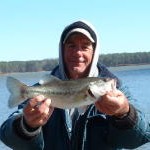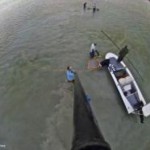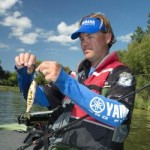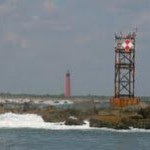
I caught this bass after a bad cold front
It never fails. All week the weather has been unusually warm for this time of year so you plan a trip to your favorite bass lake for Saturday. Everybody you talk to say the bass are tearing it up, hitting spinnerbaits, topwater lures and crankbaits in shallow water just about anywhere you want to fish.
Friday night the winds howl and the temperature drops. You are on the lake the next morning at daylight and the brightening sky shows completely clear with no haze or clouds at all. And it is cold, the coldest weather of the year so far. Water temperatures have dropped several degrees overnight.
Yep, the dreaded high pressure cold front has hit. Is it going to ruin your trip? You know bass seem to hate high pressure and dropping temperatures. So what do you do?
Bass respond to cold fronts in several ways. Why do they respond? There are a lot of theories, from higher pressure to brighter sunlight. But some of them just don’t hold up.
Even with a drastic increase in barometric pressure a bass has to move only a foot or so up or down to equal the pressure from the day before. Bass don’t seem to like bright sun but feed even on the brightest days. A change of a few degrees in temperature is more important in the spring than in the fall. And the wind that accompanies cold fronts can actually make them feed better.
No matter what the reasons, bass do change. We may never know exactly why. But there are some proven tactics that help you catch bass after a cold front blows through. Try them and catch some bass after a cold front.
In simple terms you go small, go tight, go slow, go deep, go to the wind or go to current. Go to the spotted bass if they are in the lake you fish. The baits you choose will probably change after a cold front and the places you fish varies some, but bass can still be caught if you plan to adapt.
Bass usually slow down after a cold front and won’t chase a fast moving bait. But the big exception to this is when the wind blows across a point or hits a steep bank. The wave action stirs up the baitfish, making them easier prey. The moving water pushes algae to the wind blown banks and baitfish follow, and so do the bass. And the bass can’t see your bait as well due to the broken water surface and more murky water from stirred up sediment.
One of the best ways to catch bass under these conditions is to fish the wind blown banks and points with a spinnerbait. As long as you can control your boat in the wind and waves you can find and catch bass. Find a point or steep bank where the channel swings near and fish it.
Depending on water color, a white spinnerbait with two silver willowleaf blades is best. If the water is stained try a skirt with some chartreuse in it and one or two gold blades. A heavier spinnerbait helps you cast in the wind and fish faster to cover water until you find the fish feeding. A half ounce bait works well. When you catch one you can usually catch a lot more from the same place.
Keep your boat a long cast off the bank and cast with the wind, working water from a foot deep right on the bank back to about ten feet deep. Run the spinnerbait about a foot under the surface like a confused baitfish trying to head back to deeper water.
If reeling your spinnerbait fast doesn’t work try slow rolling it a foot off the bottom, keeping it moving steadily with a slight pause every two or three feet to make the skirt flare. Don’t spend a lot of time on one place, make ten or so casts with a fast retrieve and the same number slow then move on if you don’t catch a fish. Bass school up and are concentrated on some structure but not others so keep looking until you find them.
If the wind is too strong to control your boat or you don’t find the fish or just don’t like fishing the wind, go small. Downsize your baits. If bass have been hitting a big crankbait or spinnerbait try a small one-quarter ounce bait. You have to fish the smaller spinnerbait more slowly and that is good. Slow down with the crankbait, too, if that is your choice of baits.
Also drop down to a three sixteenths ounce jig and pig or one eighth ounce jig head worm with a short finesse worm on it. These baits fall more slowly and you have to move them more slowly to keep contact with the bottom, and that is good, too. Fish around cover near where the bass have been feeding.
Work any cover you find carefully. Many bass won’t move far. If they have been feeding around stumps or rocks in six feet of water they may still be holding there and a little deeper. They may also move closer to deeper water.
Bass move often move very tight to cover after a cold front. They may still be in the exact same depths and locations but are harder to catch since they are buried in the thickest cover and won’t chase a bait very far. Take advantage of this.
Find a dock and fish it. Docks always hold bass if they have water deeper than a couple of feet under them in the fall, and they are even better if they are near deep water. But the bass get way back under them after a cold front.
One of the best ways to fish a dock after a cold front is to skip a bait as far back under it as possible. A weightless four inch Senko rigged whacky style on a weedless hook gives you small and slow and you can get them into places it is hard to get other baits.
Rig your Senko on a spinning rod with eight pound test fluorocarbon line. It takes a little practice but you can skip that bait on the lighter line all the way to the back of a dock sitting a few inches off the water. Let the bait settle to the bottom without moving your rod tip or reeling in your line.
A Senko or similar bait falls with a slow, enticing wiggling action rigged whacky style. When it hits bottom let it sit still for several seconds. Watch your line carefully for any small tick or movement. Set the hook fast and get the bass out from under the dock as quickly as possible.
Also try the posts and any brush under the dock with a small jig and pig. Pitch or skip a three-sixteenths ounce jig with a twin curly tail trailer right to the posts or to the middle of the brush. The light jig and the twin tails make the bait fall slowly and the bass often find this irresistible.
Fish other cover the same way. Find stumps and pitch a small jig and pig to them, letting the bait fall right beside them. Pitch your jig and pig into the thickest parts of a blowdown, paying careful attention to where limbs join the trunk of the fallen tree. Work all the way to the end of the tree top.
Brush piles hold bass but they bury down in the very middle of them after a cold front and not move out to feed. But a small jig and pig or Texas rigged worm dropped through the brush and jiggled in their face will get them to hit. Use heavy line, 15 to 20 pound test fluorocarbon, so you can get the fish out of the cover.
In all this cover don’t expect the bass to pick up the bait and move off. They often suck it in and not move at all. So watch for that tick when they eat your bait. Also raise your rod slowly when you move the bait. If your line is tight set the hook if there is any doubt if it is a fish.
No matter how you are fishing the cover, fish slowly. Using small baits helps but let them fall and sit as long as you can stand it. Jiggle them a little in one place as long as you can. You want to make a bass hit that is not really in a feeding mode.
Out of the wind, small spinnerbaits and crankbaits work if you move them as slowly as possible and bump them into the cover. With a spinnerbait if you hit a limb pull it up and let it fall back without coming over the limb. With a crankbait hit the cover and let it float up to drive the bass crazy.
Bass live deep and there are always deep bass but a cold front may push shallow bass deeper. Find deep structure with cover on it and the resident bass are there as well as any that have moved deeper. Small, slow moving baits work best after a cold front even in deep water.
A dropshot rig is one of the best outfits to get these bass to bite. Deep is relative on different lakes. On a clear highland type lake you may need to fish 30 plus feet of water. On more shallow lake with more stained water deep may mean 15 to 18 feet deep.
Good electronics are critical for this type fishing. Ride creek channels and drops watching for brush and stumps. When you find the cover examine it carefully for the telltale marks of fish holding in it. Even if you don’t see fish, try the deeper cover since they may be buried in the cover.
Baitfish near the cover makes it even better. If you see balls of baitfish find the closest cover and fish it hard. Shad tend to move deeper after a cold front and bass will be nearby, so take advantage of this bass attracting food.
Rig a finesse four inch worm about 18 inches above a sinker heavy enough to allow you to fish the worm in one place. If the wind is strong you may have to go to a fairly heavy drop shot weight.
Drop the rig to the bottom in the cover and tighten up your line, making the worm hover off the bottom. Barely twitch your rod tip to make the bait wiggle in place. Nose hooking the worm gives you more action but you may need to Texas rig it since you want to get the worm into thick cover.
A small jigging spoon works well, too. Try a silver one half ounce spoon if the water is clear or a gold spoon if it is stained. Spoons seem to work better if the water is fairly clear. Jig the spoon up and down in one place over and over, pulling it up a foot and letting it fall back in the same place.
With drop shot and spoons get the front of your boat right over the cover and fish and hold there, fishing both baits straight down. Sometimes you can see the bass suspended off the bottom. If you do, drop your bait down to the level they are holding and keep it in front of them.
One trick with a drop shot is to tie your hook as far above the sinker as the bass are holding off the bottom. If they are suspended five feet off the bottom, have your leader five feet long to keep the worm right in their face. This works no matter how far off the bottom they hold since you reel the fish in before getting to the lead, and it gives you exact control.
Bass in current are more active and have to feed more. Run up the river or feeder creeks in the lake until you find moving water. Rains often precede a cold front and runoff may make the current stronger, or power generation at the dam above or below the lake does the same thing.
Find eddies and pitch a small jig and pig or Texas rigged worm to those spots. Look for rocks, logs, brush and pockets where the current breaks. The bass usually hold in the lower current and feed as baitfish and other things they like, like worms or crayfish, wash to them.
Fish up the current. This gives you more boat control and allows you to fish your bait with the current in a natural movement. Pitch ahead of the boat and let your bait fall with the current into the eddy. And if you don’t like wind, you are more likely to find protected areas in the more narrow river than on the lake.
Spotted bass don’t seem to respond to cold fronts as badly as largemouth do. Florida strain largemouth that have been widely stocked out of their native range grow fast but are notorious for not feeding after a cold front. Northern and southern strain largemouth also get lock jaw after a cold front. But fish for spots and you are more likely to catch some bass.
Spots love rocks so fish rocky points and steep banks. Smaller baits are usually best for them even without a cold front, so try the same small crankbaits, spinnerbaits, worms and jig and pigs. Spots are more aggressive than largemouth all the time so you can usually fish faster, too.
For some reason spots are turned on by chartreuse. Try chartreuse spinnerbaits and crankbaits. Dip your plastic worm or jig trailer in a dip and dye like JJ’s Magic. Spots tear up a jig and pig with a curly twin tail trailer with the tips of the tails dipped to turn them chartreuse.
Don’t let a cold front get you down. Be prepared for it and catch some bass. Try these ideas and they should work for you. But no matter, it is better to go fishing than work around the house!
Tip
Dip and dye like JJ’s Magic works all the time when you are fishing, but the added colors and scent may make even more difference when fishing after a cold front. JJ’s has a strong garlic scent and comes in four colors to allow you to vary your bait color quickly, and to add highlights to your plastic baits.
Dip the tails of a green pumpkin curly tail worm or jig trailer into chartreuse JJ’s and it instantly changes color and smells strongly of garlic. The wiggling chartreuse tails look exactly like the fins of a bream and makes the bass more likely to eat it. That can make the difference between a bite and getting ignored after a cold front.











